Satas D., Tracton A.A. (ed.). Coatings Technology Handbook
Подождите немного. Документ загружается.

This Page Intentionally Left Blank
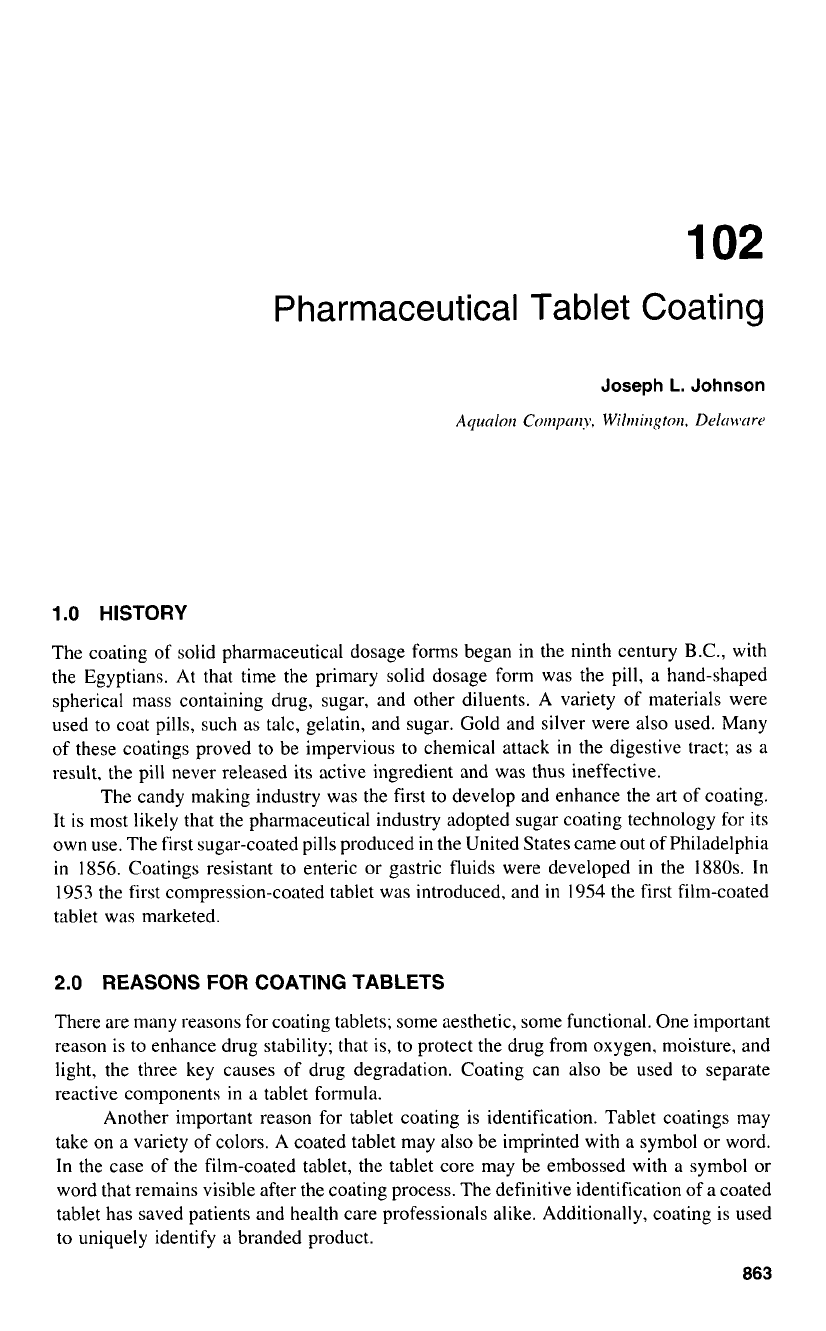
102
Pharmaceutical Tablet Coating
1
.O
HISTORY
The coating of solid pharmaceutical dosage forms began in the ninth century
B.C.,
with
the Egyptians. At that time the primary solid dosage form was the pill, a hand-shaped
spherical mass containing drug, sugar, and other diluents. A variety of materials were
used to coat pills, such
as
talc, gelatin, and sugar. Gold and silver were also used. Many
of these coatings proved
to
be impervious to chemical attack in the digestive tract;
as
a
result, the pill never released its active ingredient and was thus ineffective.
The candy making industry was the first to develop and enhance the
art
of coating.
It is most likely that the pharmaceutical industry adopted sugar coating technology for its
own use. The first sugar-coated pills produced in the United States came out of Philadelphia
in
1856.
Coatings resistant
to
enteric or gastric fluids were developed in the
1880s.
In
1953
the first cornpression-coated tablet was introduced, and in
1954
the first film-coated
tablet was marketed.
2.0
REASONS
FOR
COATING TABLETS
There are many reasons for coating tablets; some aesthetic, some functional. One important
reason is
to
enhance drug stability; that is, to protect the drug from oxygen, moisture, and
light, the three key causes
of
drug degradation. Coating can
also
be used
to
separate
reactive components
in
a tablet formula.
Another important reason for tablet coating is identification. Tablet coatings may
take
on
a
variety of colors. A coated tablet may
also
be imprinted with
a
symbol or word.
In the case of the film-coated tablet, the tablet core may be embossed with
a
symbol or
word that remains visible after the coating process. The definitive identification of
a
coated
tablet has saved patients and health care professionals alike. Additionally, coating is used
to uniquely identify a branded product.
863
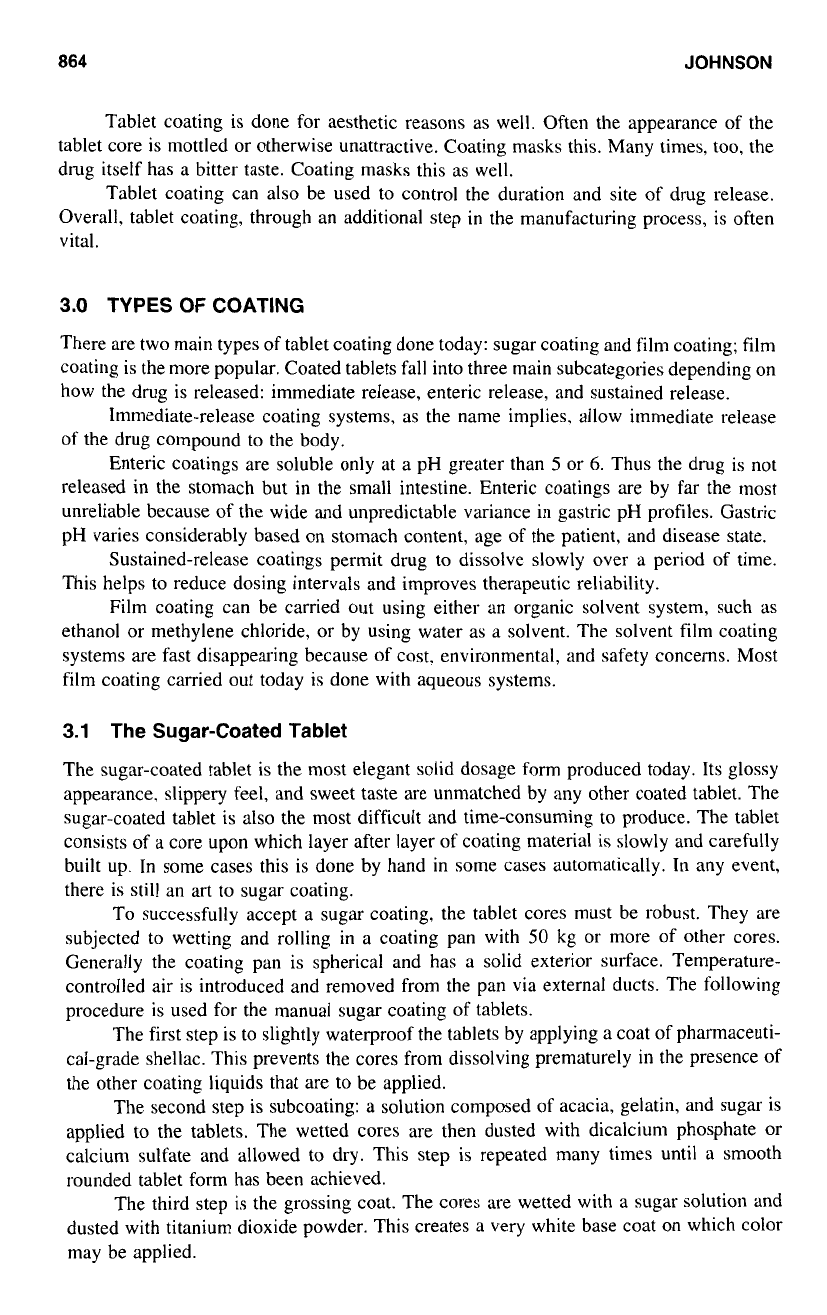
864
JOHNSON
Tablet coating is done for aesthetic reasons
as
well. Often the appearance of the
tablet core is mottled or otherwise unattractive. Coating masks this. Many times, too, the
drug itself has
a
bitter taste. Coating masks this
as
well.
Tablet coating can also be used to control the duration and site
of
drug release.
Overall. tablet coating, through
an
additional step in the manufacturing process, is often
vital.
3.0
TYPES
OF
COATING
There are two main types
of
tablet coating done today: sugar coating and film coating; film
coating is the more popular. Coated tablets fall into three main subcategories depending on
how the drug is released: immediate release, enteric release, and sustained release.
Immediate-release coating systems,
as
the name implies. allow immediate release
of the drug compound to the body.
Enteric coatings are soluble only at
a
pH greater than
5
or
6.
Thus the drug is not
released in the stomach but in the small intestine. Enteric coatings are by far the most
unreliable because
of
the wide and unpredictable variance in gastric pH profiles. Gastric
pH varies considerably based on stomach content, age of the patient, and disease state.
Sustained-release coatings permit drug to dissolve slowly over
a
period of time.
This helps to reduce dosing intervals and improves therapeutic reliability.
Film coating can be carried out using either an organic solvent system, such
as
ethanol or methylene chloride, or by using water
as
a
solvent. The solvent film coating
systems are fast disappearing because
of
cost. environmental, and safety concerns. Most
film coating carried out today is done with aqueous systems.
3.1
The Sugar-coated Tablet
The sugar-coated tablet is the most elegant solid dosage form produced today. Its
glossy
appearance, slippery feel, and sweet taste are unmatched by any other coated tablet. The
sugar-coated tablet is
also
the most difficult and time-consuming to produce. The tablet
consists
of
a
core upon which layer after layer of coating material is slowly and carefully
built up. In some cases this is done by hand in some cases automatically. In any event,
there is still
an
art
to
sugar coating.
To successfully accept a sugar coating, the tablet cores must be robust. They are
subjected to wetting and rolling
in
a
coating pan with
50
kg or more of other cores.
Generally the coating pan is spherical and has
a
solid exterior surface. Temperature-
controlled air is introduced and removed from the pan via external ducts. The following
procedure
is
used for the manual sugar coating of tablets.
The first step is to slightly waterproof the tablets by applying
a
coat of pharmaceuti-
cal-grade shellac. This prevents the cores from dissolving prematurely in the presence of
the other coating liquids that are to be applied.
The second step is subcoating: a solution composed
of
acacia, gelatin, and sugar is
applied to the tablets. The wetted cores are then dusted with dicalcium phosphate or
calcium sulfate and allowed to dry. This step is repeated many times until
a
smooth
rounded tablet form has been achieved.
The third step is the grossing coat. The cores are wetted with
a
sugar solution and
dusted with titanium dioxide powder. This creates
a
very white base coat on which color
may be applied.
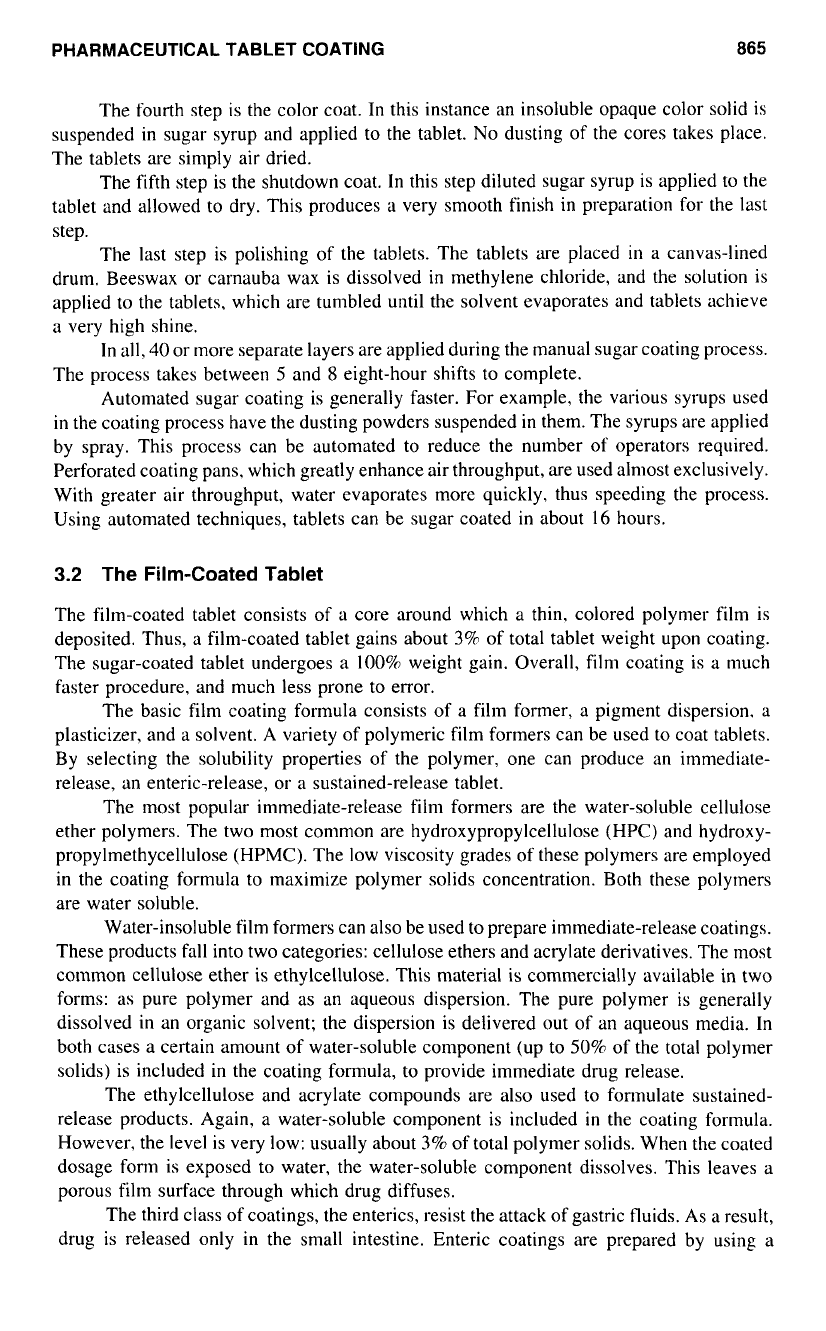
PHARMACEUTICAL TABLET COATING
865
The fourth step is the color coat. In this instance an insoluble opaque color solid is
suspended in sugar syrup and applied
to
the tablet.
No
dusting of the cores takes place.
The tablets are simply air dried.
The fifth step is the shutdown coat.
In
this step diluted sugar syrup is applied to the
tablet and allowed to dry. This produces a very smooth finish in preparation for the last
step.
The last step is polishing of
the
tablets. The tablets are placed
in
a canvas-lined
drum. Beeswax or carnauba wax is dissolved
in
methylene chloride, and the solution is
applied to the tablets, which are tumbled until the solvent evaporates and tablets achieve
a
very high shine.
In
all.
40
or more separate layers are applied during the manual sugar coating process.
The process takes between
5
and
8
eight-hour shifts to complete.
Automated sugar coating is generally faster. For example, the various syrups used
in the coating process have the dusting powders suspended
in
them. The syrups are applied
by spray. This process can be automated to reduce the number of operators required.
Perforated coating pans, which greatly enhance air throughput, are used almost exclusively.
With greater air throughput, water evaporates more quickly, thus speeding the process.
Using automated techniques, tablets can be sugar coated in about
16
hours.
3.2
The Film-Coated Tablet
The film-coated tablet consists of a core around which a thin, colored polymer film is
deposited. Thus, a film-coated tablet gains about
3%
of total tablet weight upon coating.
The sugar-coated tablet undergoes
a
100%
weight gain. Overall, film coating is a much
faster procedure, and much less prone to error.
The basic film coating formula consists of a film former, a pigment dispersion. a
plasticizer. and a solvent.
A
variety
of
polymeric film formers can be used
to
coat tablets.
By selecting the solubility properties of the polymer, one can produce an immediate-
release, an enteric-release, or
a
sustained-release tablet.
The most popular immediate-release film formers are the water-soluble cellulose
ether polymers. The two most common are hydroxypropylcellulose (HPC) and hydroxy-
propylmethycellulose (HPMC). The low viscosity grades of these polymers are employed
in the coating formula to maximize polymer solids concentration. Both these polymers
are water soluble.
Water-insoluble film formers can also be used
to
prepare immediate-release coatings.
These products fall into two categories: cellulose ethers and acrylate derivatives. The most
common cellulose ether is ethylcellulose. This material is commercially available in two
forms: as pure polymer and as an aqueous dispersion. The pure polymer is generally
dissolved in an organic solvent; the dispersion is delivered out of an aqueous media.
In
both cases
a
certain amount of water-soluble component (up to
50%
of the total polymer
solids) is included
in
the coating formula, to provide immediate drug release.
The ethylcellulose and acrylate compounds are
also
used
to
formulate sustained-
release products. Again,
a
water-soluble component is included
in
the coating formula.
However, the level is very low: usually about
3%
of
total polymer solids. When the coated
dosage form is exposed to water, the water-soluble component dissolves. This leaves
a
porous film surface through which drug diffuses.
The third class ofcoatings, the enterics, resist the attack of gastric tluids.
As
a result,
drug is released only in the small intestine. Enteric coatings are prepared by using a
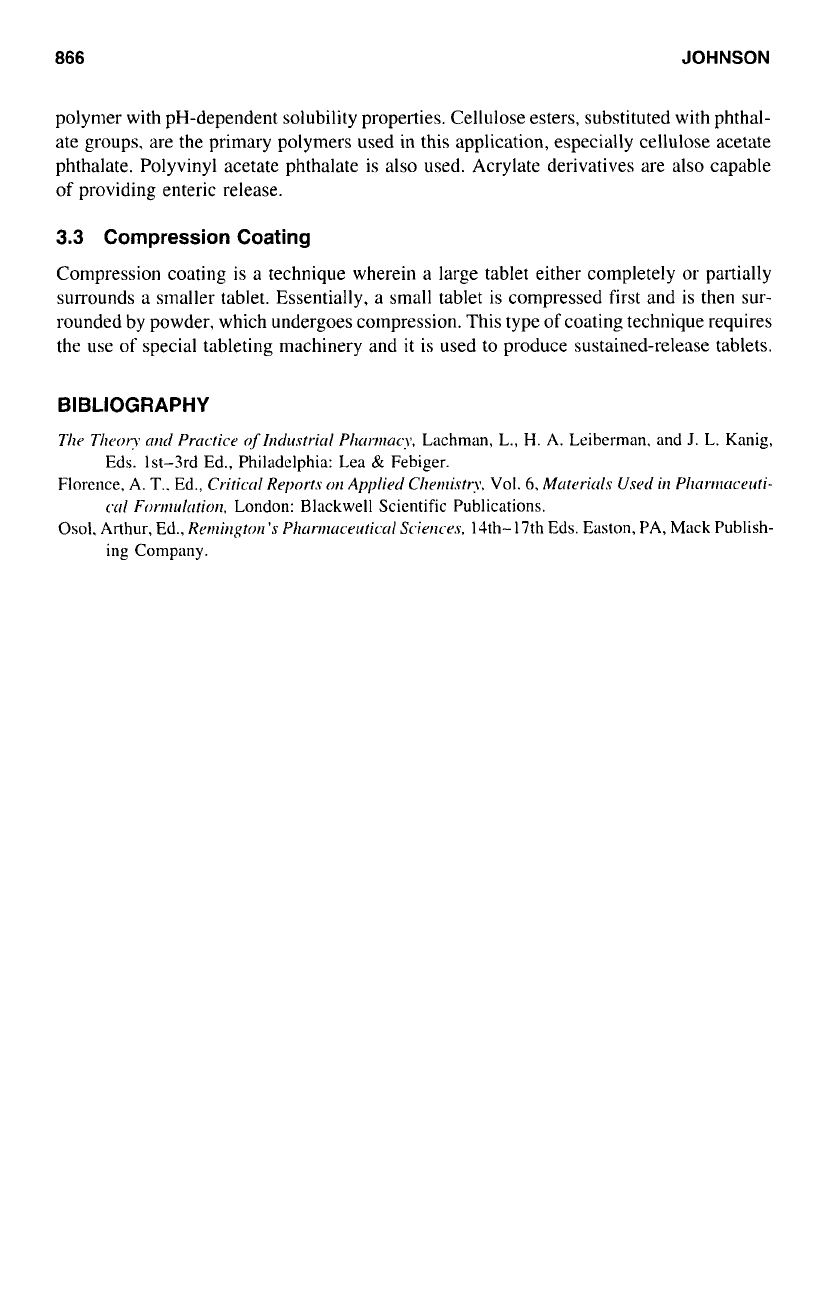
866
JOHNSON
polymer with pH-dependent solubility properties. Cellulose esters, substituted with phthal-
ate groups, are the primary polymers used in this application, especially cellulose acetate
phthalate. Polyvinyl acetate phthalate is also used. Acrylate derivatives are also capable
of providing enteric release.
3.3
Compression
Coating
Compression coating is
a
technique wherein a large tablet either completely or partially
surrounds a smaller tablet. Essentially,
a
small tablet is compressed first and is then sur-
rounded by powder, which undergoes compression. This type of coating technique requires
the use of special tableting machinery and
it
is
used to produce sustained-release tablets.
BIBLIOGRAPHY
TIIP
Tl~eot?
crnd
Prrrctice
ofIndu.wYd
Hzwtnucy,
Lachman, L.,
H.
A. Leiberman, and
J.
L. Kanig,
Florcnce, A.
T..
Ed.,
Criricrrl
Reports
on
Applied
C/wnistt.y,
Vol.
6,
Morerids
Used
irl
P~IN~III(Ic~I~~~-
Osol.
Arthur, Ed.,
Rernirlgtorz’s
Pllanrzcrcercticcrl
Sciewes.
14th-
17th Eds. Easton, PA, Mack Publish-
Eds. 1st-3rd Ed., Philadclphia: Lea
&
Febiger.
c~rl
Formultrriorz.
London: Blackwell Scientific Publications.
ing Company.
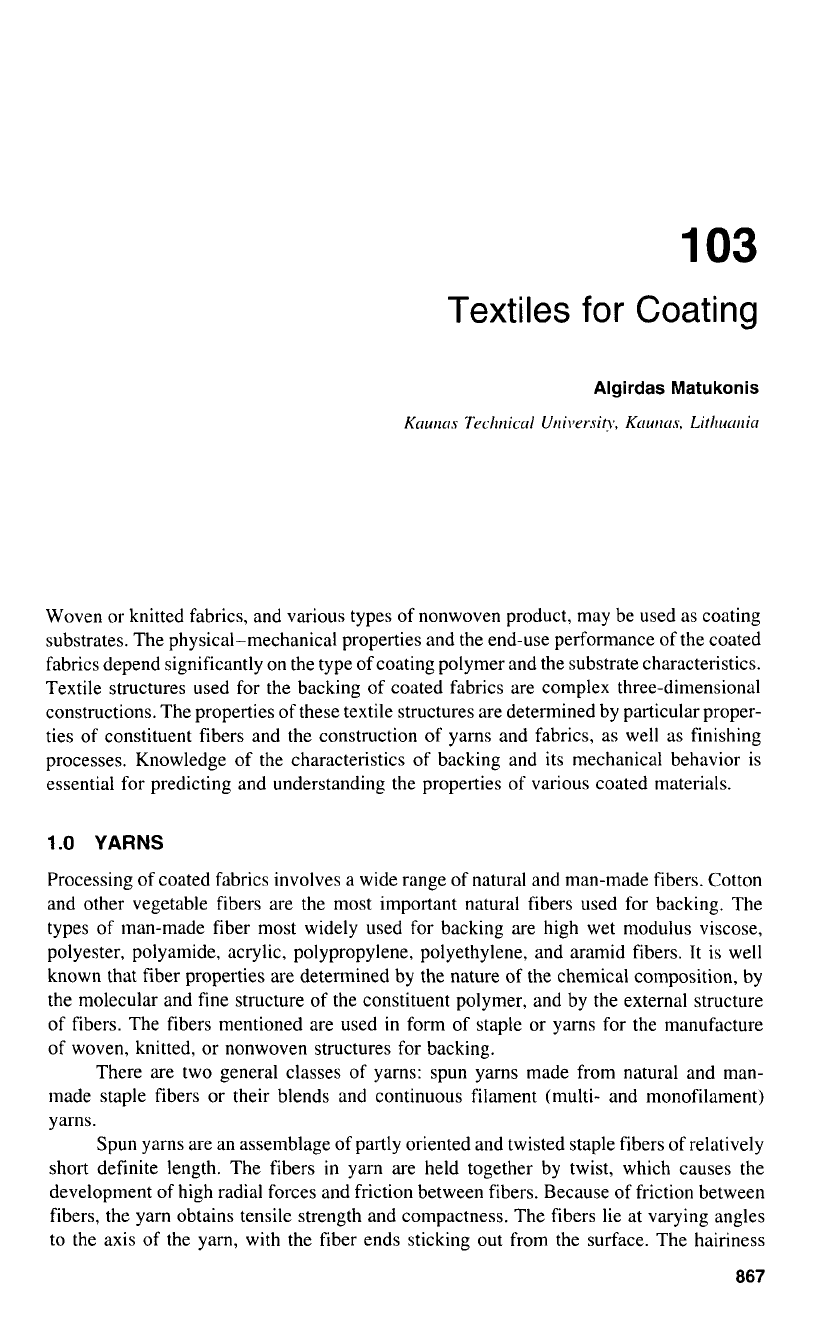
103
Textiles
for
Coating
Woven or knitted fabrics, and various types of nonwoven product, may be used
as
coating
substrates. The physical-mechanical properties and the end-use performance of the coated
fabrics depend significantly on the type of coating polymer and the substrate characteristics.
Textile structures used for the backing of coated fabrics are complex three-dimensional
constructions. The properties of these textile structures are determined by particular proper-
ties of constituent fibers and the construction
of
yarns and fabrics,
as
well
as
finishing
processes. Knowledge of the characteristics of backing and its mechanical behavior is
essential for predicting and understanding the properties of various coated materials.
1.0
YARNS
Processing
of
coated fabrics involves a wide range of natural and man-made fibers. Cotton
and other vegetable fibers are the most important natural fibers used for backing. The
types of man-made fiber most widely used for backing are high wet modulus viscose,
polyester, polyamide, acrylic, polypropylene, polyethylene, and aramid fibers. It is well
known that fiber properties are determined by the nature
of
the chemical composition, by
the molecular and fine structure of the constituent polymer, and by the external structure
of fibers. The fibers mentioned are used
in
form of staple or yams for the manufacture
of woven, knitted, or nonwoven structures for backing.
There are two general classes of yarns: spun yarns made from natural and man-
made staple fibers or their blends and continuous filament (multi- and monofilament)
yarns.
Spun yarns are an assemblage of partly oriented and twisted staple fibers of relatively
short definite length. The fibers in yarn are held together by twist, which causes the
development of high radial forces and friction between fibers. Because of friction between
fibers, the yarn obtains tensile strength and compactness. The fibers lie at varying angles
to the axis of the yarn, with the fiber ends sticking out from the surface. The hairiness
867
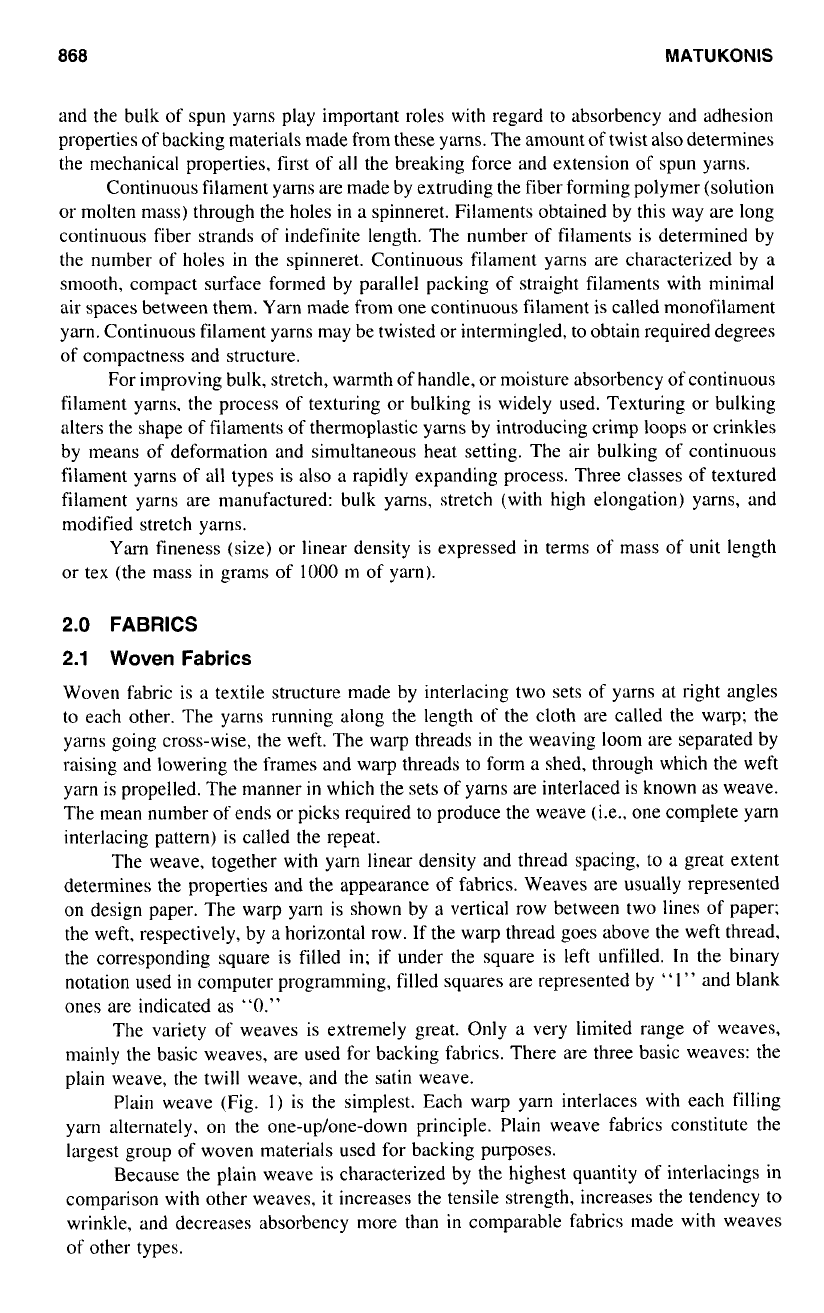
868
MATUKONIS
and the bulk of spun yarns play important roles with regard
to
absorbency and adhesion
properties
of
backing materials made from these yarns. The amount
of
twist also determines
the mechanical properties, first of all the breaking force and extension of spun yarns.
Continuous filament yams are made by extruding the fiber forming polymer (solution
or molten mass) through the holes
in
a spinneret. Filaments obtained by this way are long
continuous fiber strands of indefinite length. The number of filaments is determined by
the number of holes in the spinneret. Continuous filament yarns are characterized by a
smooth, compact surface formed by parallel packing of straight filaments with minimal
air spaces between them. Yarn made from one continuous filament is called monofilament
yarn. Continuous filament yarns may be twisted or intermingled, to obtain required degrees
of compactness and structure.
For improving bulk, stretch, warmth of handle, or moisture absorbency
of
continuous
filament yarns. the process of texturing or bulking is widely used. Texturing or bulking
alters the shape of filaments
of
thermoplastic yarns by introducing crimp loops or crinkles
by means of deformation and simultaneous heat setting. The air bulking
of
continuous
filament yarns
of
all types is also a rapidly expanding process. Three classes
of
textured
filament yarns are manufactured: bulk yams, stretch (with high elongation) yarns, and
modified stretch yarns.
Yarn fineness (size) or linear density is expressed
in
terms of mass of unit length
or tex (the n1ass in grams of
1000
m of yarn).
2.0
FABRICS
2.1
Woven
Fabrics
Woven fabric is a textile structure made by interlacing two sets
of
yarns at right angles
to each other. The yarns running along the length of the cloth are called the warp; the
yarns going cross-wise, the weft. The warp threads
in
the weaving loom are separated by
raising and lowering the frames and warp threads
to
form a shed, through which the weft
yarn is propelled. The manner
in
which the sets of yams are interlaced is known as weave.
The mean number
of
ends or picks required
to
produce the weave (i.e., one complete yarn
interlacing pattern) is called the repeat.
The weave, together with yarn linear density and thread spacing,
to
a great extent
determines the properties and the appearance
of
fabrics. Weaves are usually represented
on design paper. The warp yarn is shown by
a
vertical row between two lines of paper;
the weft, respectively, by a horizontal row. If the warp thread goes above the weft thread.
the corresponding square is filled in; if under the square is left unfilled.
In
the binary
notation used
in
computer programming, filled squares are represented by
“
1
”
and blank
ones are indicated as
“0.”
The variety of weaves is extremely great. Only a very limited range of weaves,
mainly the basic weaves, are used for backing fabrics. There are three basic weaves: the
plain weave, the twill weave, and the satin weave.
Plain weave (Fig.
l)
is the simplest. Each warp yarn interlaces with each filling
yarn alternately.
on
the one-up/one-down principle. Plain weave fabrics constitute the
largest group of woven materials used for backing purposes.
Because the plain weave is characterized by the highest quantity
of
interlacings in
comparison with other weaves, it increases the tensile strength, increases the tendency
to
wrinkle, and decreases absorbency more than
in
comparable fabrics made with weaves
of other types.
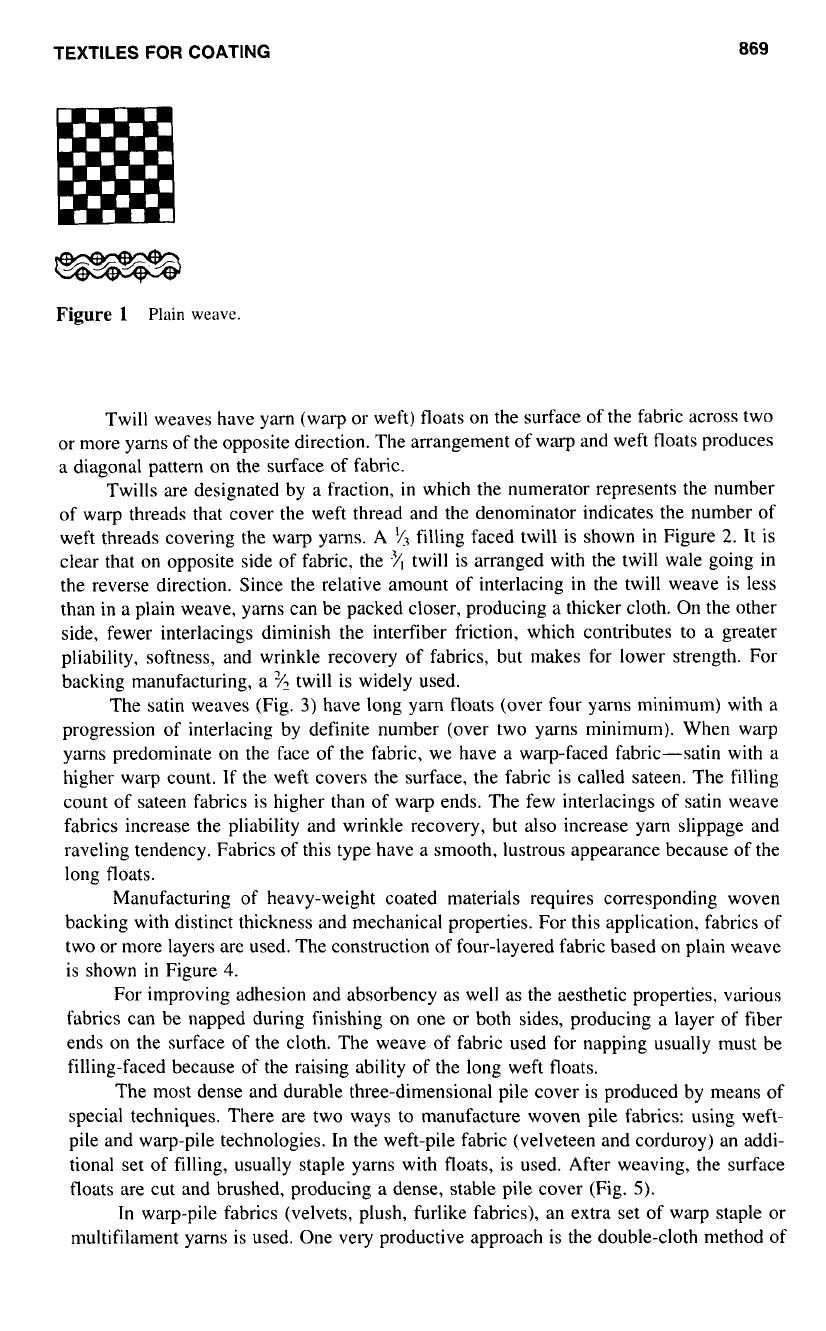
TEXTILES
FOR
COATING
869
Figure
1
Plain
weave.
Twill weaves have yarn (warp or weft) floats
on
the surface of the fabric across two
or more yams of the opposite direction. The arrangement of warp and weft floats produces
a
diagonal pattern on the surface of fabric.
Twills are designated by
a
fraction,
in
which the numerator represents the number
of
warp threads that cover the weft thread and the denominator indicates the number
of
weft threads covering the warp yarns.
A
y3
filling faced twill is shown
in
Figure
2.
It is
clear that
on
opposite side
of
fabric. the
%
twill is arranged with the twill wale going
in
the reverse direction. Since the relative amount of interlacing
in
the twill weave is less
than in
a
plain weave, yams can be packed closer, producing a thicker cloth. On the other
side, fewer interlacings diminish the interfiber friction, which contributes to
a
greater
pliability, softness, and wrinkle recovery of fabrics, but makes for lower strength. For
backing manufacturing,
a
'/.
twill is widely used.
The satin weaves (Fig.
3)
have long yam floats (over four yarns minimum) with
a
progression
of
interlacing by definite number (over two yarns minimum). When warp
yarns predominate on the face of the fabric, we have a warp-faced fabric-satin with a
higher warp count.
If
the weft covers the surface, the fabric is called sateen. The filling
count of sateen fabrics is higher than of warp ends. The few interlacings of satin weave
fabrics increase the pliability and wrinkle recovery, but also increase yarn slippage and
raveling tendency. Fabrics
of
this type have
a
smooth, lustrous appearance because of the
long floats.
Manufacturing of heavy-weight coated materials requires corresponding woven
backing with distinct thickness and mechanical properties. For this application, fabrics of
two or more layers are used. The construction
of
four-layered fabric based on plain weave
is shown in Figure
4.
For improving adhesion and absorbency as well
as
the aesthetic properties, various
fabrics can be napped during finishing on one or both sides, producing
a
layer of fiber
ends on the surface of the cloth. The weave
of
fabric used for napping usually must be
filling-faced because
of
the raising ability of the long weft floats.
The most dense and durable three-dimensional pile cover is produced by means of
special techniques. There are two ways to manufacture woven pile fabrics: using weft-
pile and warp-pile technologies. In the weft-pile fabric (velveteen and corduroy) an addi-
tional set
of
filling, usually staple yarns with floats, is used. After weaving, the surface
floats are cut and brushed, producing a dense, stable pile cover (Fig.
5).
In warp-pile fabrics (velvets, plush, furlike fabrics), an extra set of warp staple or
multifilament yarns is used. One very productive approach is the double-cloth method of
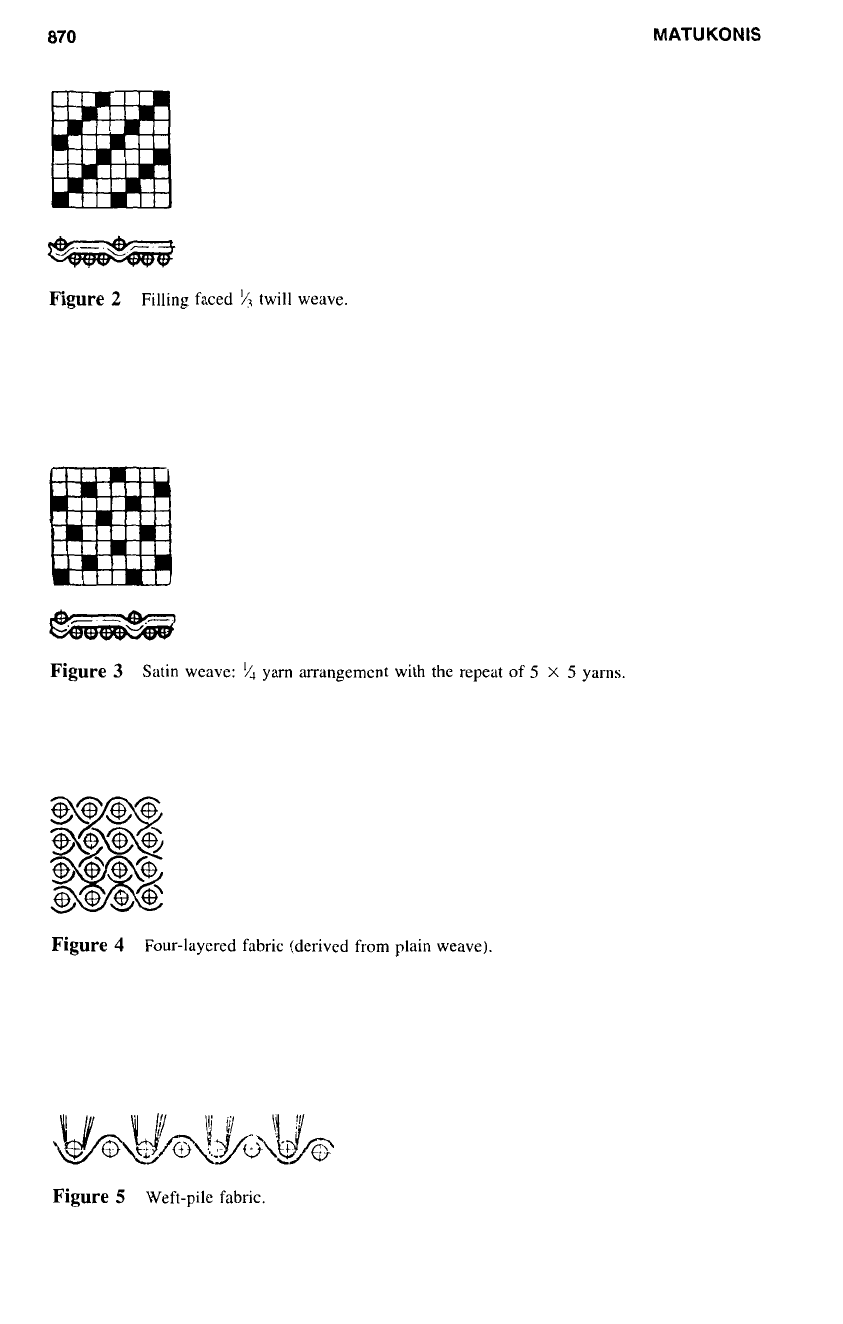
870
MATUKONIS
Figure
2
Filling faced twill weave.
Figure
3
Satin weave:
'/J
yam arrangement with the repeat of
5
X
5
yarns.
Figure
4
Four-laycred fabric (derived from plain weave).
Figure
5
Weft-pile fabric.
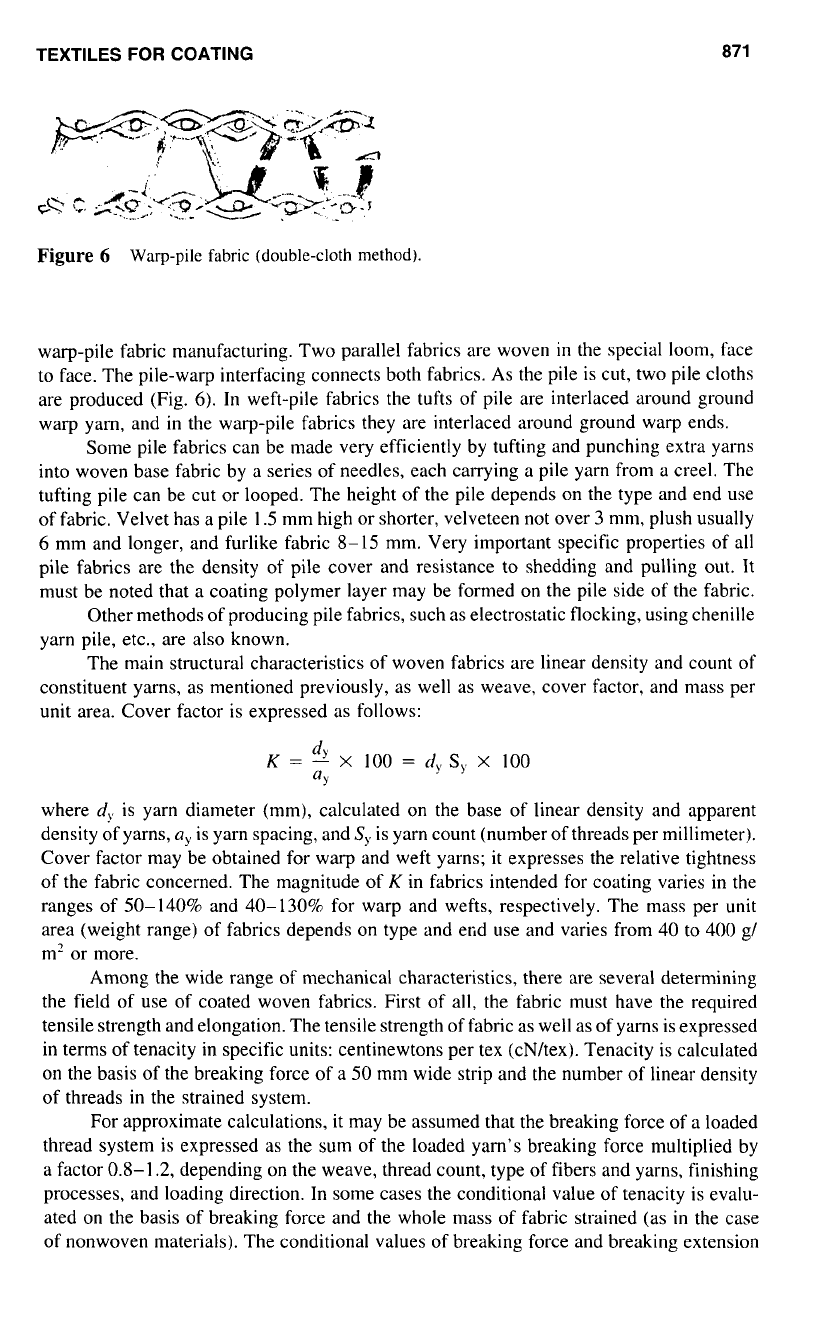
TEXTILES
FOR
COATING
871
Figure
6
Warp-pile
fabric (double-cloth
method).
warp-pile fabric manufacturing. Two parallel fabrics are woven
in
the special loom, face
to face. The pile-warp interfacing connects both fabrics. As the pile is cut, two pile cloths
are produced (Fig.
6).
In
weft-pile fabrics the tufts of pile are interlaced around ground
warp yam, and in the warp-pile fabrics they are interlaced around ground warp ends.
Some pile fabrics can be made very efficiently by tufting and punching extra yarns
into woven base fabric by
a
series of needles, each carrying
a
pile yarn from a creel. The
tufting pile can be cut or looped. The height of the pile depends on the type and end use
of fabric. Velvet has
a
pile
1.5
mm high or shorter, velveteen
not
over
3
mm, plush usually
6
mm and longer, and furlike fabric
8-15
mm. Very important specific properties of
all
pile fabrics are the density of pile cover and resistance to shedding and pulling out. It
must be noted that
a
coating polymer layer may be formed
on
the pile side of the fabric.
Other methods of producing pile fabrics, such
as
electrostatic flocking, using chenille
yarn pile, etc., are
also
known.
The main structural characteristics of woven fabrics are linear density and count of
constituent yarns, as mentioned previously,
as
well
as
weave, cover factor, and mass per
unit area. Cover factor is expressed as follows:
K
=
-
X
100
=
d,
S,.
X
100
4
UY
where
d,.
is yarn diameter (mm), calculated on the base of linear density and apparent
density of yarns,
U,,
is yarn spacing, and
S,.
is yarn count (number
of
threads per millimeter).
Cover factor maybe obtained for warp and weft yarns;
it
expresses the relative tightness
of
the fabric concerned. The magnitude of
K
in fabrics intended for coating varies in the
ranges
of
50-140% and
40-130%
for warp and wefts, respectively. The mass per
unit
area (weight range)
of
fabrics depends on type and etid use and varies from 40
to
400 g/
m' or more.
Among the wide range of mechanical characteristics, there are several determining
the field of use of coated woven fabrics. First
of
all,
the fabric must have the required
tensile strength and elongation. The tensile strength of fabric
as
well
as
of yarns is expressed
in terms of tenacity in specific units: centinewtons per tex (cN/tex). Tenacity is calculated
on the basis of the breaking force of a
50
mm wide strip and the number
of
linear density
of
threads in the strained system.
For approximate calculations, it may be assumed that the breaking force
of
a
loaded
thread system is expressed
as
the sum of the loaded yarn's breaking force multiplied by
a
factor 0.8-1.2, depending on the weave, thread count, type
of
fibers and yarns, finishing
processes, and loading direction. In some cases the conditional value
of
tenacity is evalu-
ated on the basis of breaking force and the whole mass of fabric strained
(as
in
the case
of nonwoven materials). The conditional values of breaking force and breaking extension
